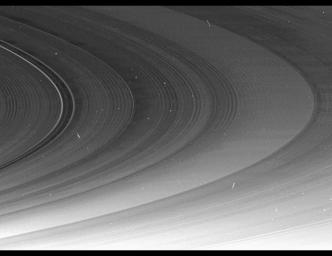Inner B Ring Terminus
Caption:
This mosaic of Cassini images, part of a larger mosaic of images captured just hours before exact equinox at Saturn, shows that the spiral corrugation in the planet's inner rings continues right up to the inner B ring ... an unexpected result that scientists are working to understand.
The inner B ring boundary is visible on the right. The C ring's Maxwell Gap, demarcated by two bright arcs in this view, is on the left.
The larger mosaic shows a gently undulating pattern stretching from the D ring to inner B ring (see
PIA11670
).
An earlier mosaic, captured in June, showed the corrugation extending only as far as the middle of the C ring (see
PIA11664
).
The periodic brightness variations in this corrugation are most likely caused by the changing slopes in the rippled ring plane, much like the corrugations of a tin roof. Although previous Cassini observations (see
PIA08325
) had revealed corrugations in the D ring extending over 500 miles (800 kilometers), this image now shows these features extending beyond their origin in the D ring for 11,000 miles (17,000 kilometers) into the C ring. This new imagery supports earlier evidence that something happened in the early 1980s to generate this feature.
In 2006, imaging scientists speculated that a collision with a comet or asteroid may have disturbed the D ring. That explanation seems less likely now that this new image shows the effect spread over a much broader radial range, extending completely across the C ring, and scientists are continuing to investigate the cause of this disturbance.
Whatever created the corrugation apparently tilted a vast region of the inner rings relative to Saturn's gravitational field in a relatively short period of time during the early 1980s. In the intervening years, the natural tendency for inclined orbits to systematically and slowly wobble at different rates, depending on their distance from Saturn, has created a tightly wound spiral corrugation in the ring plane.
This view and others like it are only possible around the time of Saturn's equinox which occurs every half-Saturn-year (equivalent to about 15 Earth years). Exact equinox is when the sun is directly overhead at the equator. The illumination geometry that accompanies equinox lowers the sun's angle to the ring plane, significantly darkens the rings, and causes out-of-plane structures to cast long shadows across the rings. Cassini's cameras have spotted not only the predictable shadows of some of Saturn's moons (see
PIA11657
), but also the shadows of newly revealed vertical structures in the rings themselves (see
PIA11665
).
This view looks toward the southern side of the rings from about 4 degrees below the ring plane. Background stars are visible shining through the rings, and the image has not been cleaned to remove cosmic rays, which struck the camera's detector during the exposures.
The image was taken in visible light with the Cassini spacecraft narrow-angle camera on Aug. 10, 2009. The view was acquired at a distance of approximately 888,000 kilometers (552,000 miles) from Saturn and at a Sun-Saturn-spacecraft, or phase, angle of 157 degrees. Image scale is 5 kilometers (3 miles) per pixel.
Background Info:
The Cassini-Huygens mission is a cooperative project of NASA, the European Space Agency and the Italian Space Agency. The Jet Propulsion Laboratory, a division of the California Institute of Technology in Pasadena, manages the mission for NASA's Science Mission Directorate, Washington, D.C. The Cassini orbiter and its two onboard cameras were designed, developed and assembled at JPL. The imaging operations center is based at the Space Science Institute in Boulder, Colo.
For more information about the Cassini-Huygens mission visit
http://saturn.jpl.nasa.gov/
. The Cassini imaging team homepage is at
http://ciclops.org
.
Cataloging Keywords:
| Name |
Value |
Additional Values |
| Target |
Saturn Rings |
B Ring, Saturn |
| System |
Saturn |
|
| Target Type |
Ring |
Planet, Satellite |
| Mission |
Cassini-Huygens |
|
| Instrument Host |
Cassini Orbiter |
|
| Host Type |
Orbiter |
|
| Instrument |
Imaging Science Subsystem (ISS) |
|
| Detector |
Narrow Angle Camera |
|
| Extra Keywords |
Asteroid, Collision, Comet, Gap, Grayscale, Shadow, Visual |
| Acquisition Date |
|
| Release Date |
2009-09-21 |
| Date in Caption |
2009-08-10 |
|
| Image Credit |
NASA/JPL/Space Science Institute |
| Source |
photojournal.jpl.nasa.gov/catalog/PIA11671 |
| Identifier |
PIA11671 |

 Planetary Data System
Planetary Data System
